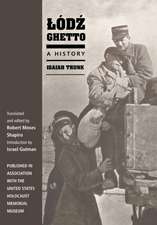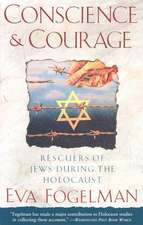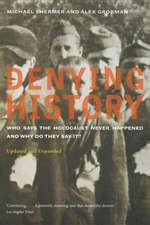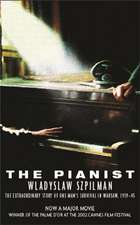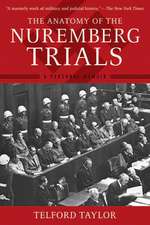Pack of Thieves: How Hitler and Europe Plundered the Jews and Committed the Greatest Theft in History
Autor Richard Z. Chesnoffen Limba Engleză Paperback – 31 dec 2000
Preț: 110.75 lei
Nou
Puncte Express: 166
Preț estimativ în valută:
21.19€ • 23.01$ • 17.80£
21.19€ • 23.01$ • 17.80£
Carte disponibilă
Livrare economică 01-15 aprilie
Preluare comenzi: 021 569.72.76
Specificații
ISBN-13: 9780385720649
ISBN-10: 0385720645
Pagini: 352
Ilustrații: 15 PAGES ILLUSTRATIONS
Dimensiuni: 132 x 203 x 18 mm
Greutate: 0.33 kg
Ediția:Anchor Books.
Editura: Anchor Books
ISBN-10: 0385720645
Pagini: 352
Ilustrații: 15 PAGES ILLUSTRATIONS
Dimensiuni: 132 x 203 x 18 mm
Greutate: 0.33 kg
Ediția:Anchor Books.
Editura: Anchor Books
Notă biografică
Richard Z. Chesnoff is a senior correspondent for U.S. News & World Report and op-ed columnist for the New York Daily News. Winner of both the Overseas Press Club and National Press Club awards, he has covered many of the major events and personalities of our times for more than thirty years. He lives in New York and France.
From the Hardcover edition.
From the Hardcover edition.
Extras
CHAPTER FOUR
THE NETHERLANDS: LOOT THY NEIGHBOR
"Terrible things are happening outside. At any time of night and day,poor helpless people are being dragged out of their homes. They're allowed to take only a knapsack and a little cash, and even then,they're robbed of these possessions on the way."
Anne Frank, January 13, 1943
Like the people who speak it, Dutch is a precise language. There are terms to denote the specific turn of a tulip petal, words for differing depths of winter ice on Holland's canals. The language of the Lowlands may also be the only one in the world with a specific verb for the systematic looting of a house: pulsen. It is derived from Abraham Puls & Sons, the name of the notorious Amsterdam moving-van company that Nazi-directed Dutch police employed to pillage and empty the homes of the 140,000 Jews of the Netherlands who were forced into hiding or shipped to their deaths during the Nazi occupation.
No Jewish community in Western Europe suffered more during the Holocaust than the Jews of Holland. Out of a prewar population of 140,000 (including 15,000 refugees from Nazi Austria and Germany), barely 15,000 Dutch Jews survived the four years of Nazi terror. A lucky handful escaped the death camps by fleeing before the invasion. But most of those who survived the war in Holland did so by hiding with the help of a network of brave countrymen who risked their own lives for the sake of others -- usually total strangers.
The heroism of Holland's savers is legendary: the anonymous volunteers who waited outside the internment center at Amsterdam's Hollandsche Schouwburg theater to catch children literally tossed over the wall in a frantic last-minute attempt to save them from deportation; the underground railroad of workers, housewives, students, and clergy who passed fugitive Jews from one to the other, then sheltered them in attics, in basements -- or in the case of the smallest children, raised them as their own; the brave souls like the gentle Miep Gies who at enormous risk to herself and her own kin helped hide three Jewish families, among them a young girl named Anne Frank.
But Holland's Anne Franks were few in number, and even the twelve-year-old diarist whose notebooks came to symbolize the Holocaust ultimately was betrayed by a Dutchman. For every Dutch Jew saved, ten others were shipped to their deaths for lack of neighbors willing to help -- or for the abundance of those
eager to collaborate and collect the seven-guilder reward the Germans offered per hidden Jew. Other Dutchmen and -women took their rewards from the Nazis in kind. Within hours of their arrest on August 4, 1944, the hiding place of
Anne Frank and her family was ransacked and looted --- some say by her Dutch neighbors, others by the Dutch-owned, Nazi-hired Puls moving company.
"This country took care of very few Anne Franks,'' says Dutch economist Victor Halberstadt, himself a hidden child during three years of the war. ""The government did not protect us during the war. And when those of us who survived came back, the government was not particularly interested in us.''
Most historians believe that the Nazis had hoped to gain broad popular Dutch support for their pan-Germanic plans. Eager, therefore, not to alarm the Dutch population, Seyss-Inquart waited until September 1940 to declare the first harsh legislation separating Dutch Jews from their Christian countrymen????.
??The Germans and their growing number of Dutch collaborators soon pulled out all stops. By the autumn of 1940, Holland's non-Jewish government employees had all been ordered to sign ""Aryan declarations,'' sworn statements that no Jewish blood ran in their veins. Those who refused to do so were presumed Jews under the same criteria as the Nuremberg racial laws of 1935 and summarily expelled from the Dutch civil service.
Other Aryanization measures soon followed. On October 22, 1940, decree VO189/40 ordered the immediate registration of all Jewish enterprises as well as that of any other businesses in which Dutch Jews held large shares. The administration of some 20,960 Jewish enterprises was turned over to a Nazi ""Commissariat General for Finance and Economy.''
Eager to maintain as much of their family possessions as possible, many Dutch Jews turned over assets to Christian neighbors, business partners, and lawyers for safekeeping. The safeKeepers soon won the Dutch slang sobriquet bewariers, or ""Aryan guards.''
""There was an unwritten understanding that [the property] would be returned after the war,'' says Dutch historian Gerard Aalders, a premier researcher of the period. ""However, the fact is, much of the property was never returned, and the Jewish owners, if they survived, were unable to do anything if they could not prove ownership.''
Dutch Holocaust survivor Yohanan Heimans, who now lives in Israel, puts it more bluntly: ""The property we left with the guardians was so well protected that they didn't return it to us.
From the Hardcover edition.
THE NETHERLANDS: LOOT THY NEIGHBOR
"Terrible things are happening outside. At any time of night and day,poor helpless people are being dragged out of their homes. They're allowed to take only a knapsack and a little cash, and even then,they're robbed of these possessions on the way."
Anne Frank, January 13, 1943
Like the people who speak it, Dutch is a precise language. There are terms to denote the specific turn of a tulip petal, words for differing depths of winter ice on Holland's canals. The language of the Lowlands may also be the only one in the world with a specific verb for the systematic looting of a house: pulsen. It is derived from Abraham Puls & Sons, the name of the notorious Amsterdam moving-van company that Nazi-directed Dutch police employed to pillage and empty the homes of the 140,000 Jews of the Netherlands who were forced into hiding or shipped to their deaths during the Nazi occupation.
No Jewish community in Western Europe suffered more during the Holocaust than the Jews of Holland. Out of a prewar population of 140,000 (including 15,000 refugees from Nazi Austria and Germany), barely 15,000 Dutch Jews survived the four years of Nazi terror. A lucky handful escaped the death camps by fleeing before the invasion. But most of those who survived the war in Holland did so by hiding with the help of a network of brave countrymen who risked their own lives for the sake of others -- usually total strangers.
The heroism of Holland's savers is legendary: the anonymous volunteers who waited outside the internment center at Amsterdam's Hollandsche Schouwburg theater to catch children literally tossed over the wall in a frantic last-minute attempt to save them from deportation; the underground railroad of workers, housewives, students, and clergy who passed fugitive Jews from one to the other, then sheltered them in attics, in basements -- or in the case of the smallest children, raised them as their own; the brave souls like the gentle Miep Gies who at enormous risk to herself and her own kin helped hide three Jewish families, among them a young girl named Anne Frank.
But Holland's Anne Franks were few in number, and even the twelve-year-old diarist whose notebooks came to symbolize the Holocaust ultimately was betrayed by a Dutchman. For every Dutch Jew saved, ten others were shipped to their deaths for lack of neighbors willing to help -- or for the abundance of those
eager to collaborate and collect the seven-guilder reward the Germans offered per hidden Jew. Other Dutchmen and -women took their rewards from the Nazis in kind. Within hours of their arrest on August 4, 1944, the hiding place of
Anne Frank and her family was ransacked and looted --- some say by her Dutch neighbors, others by the Dutch-owned, Nazi-hired Puls moving company.
"This country took care of very few Anne Franks,'' says Dutch economist Victor Halberstadt, himself a hidden child during three years of the war. ""The government did not protect us during the war. And when those of us who survived came back, the government was not particularly interested in us.''
Most historians believe that the Nazis had hoped to gain broad popular Dutch support for their pan-Germanic plans. Eager, therefore, not to alarm the Dutch population, Seyss-Inquart waited until September 1940 to declare the first harsh legislation separating Dutch Jews from their Christian countrymen????.
??The Germans and their growing number of Dutch collaborators soon pulled out all stops. By the autumn of 1940, Holland's non-Jewish government employees had all been ordered to sign ""Aryan declarations,'' sworn statements that no Jewish blood ran in their veins. Those who refused to do so were presumed Jews under the same criteria as the Nuremberg racial laws of 1935 and summarily expelled from the Dutch civil service.
Other Aryanization measures soon followed. On October 22, 1940, decree VO189/40 ordered the immediate registration of all Jewish enterprises as well as that of any other businesses in which Dutch Jews held large shares. The administration of some 20,960 Jewish enterprises was turned over to a Nazi ""Commissariat General for Finance and Economy.''
Eager to maintain as much of their family possessions as possible, many Dutch Jews turned over assets to Christian neighbors, business partners, and lawyers for safekeeping. The safeKeepers soon won the Dutch slang sobriquet bewariers, or ""Aryan guards.''
""There was an unwritten understanding that [the property] would be returned after the war,'' says Dutch historian Gerard Aalders, a premier researcher of the period. ""However, the fact is, much of the property was never returned, and the Jewish owners, if they survived, were unable to do anything if they could not prove ownership.''
Dutch Holocaust survivor Yohanan Heimans, who now lives in Israel, puts it more bluntly: ""The property we left with the guardians was so well protected that they didn't return it to us.
From the Hardcover edition.
Recenzii
“Chesnoff has not only carefully investigated the details of Hitler’s crime, but with his descriptive pen in hand has created a fascinating story that does not give the reader a moment’s rest."–Shimon Peres
Descriere
Journalist Chesnoff presents the story of the largest organized robbery in history: the systematic looting of Europe's Jews by the Nazis, in cooperation with most of the nations in Europe, and how Swiss banks hoarded the assets of Holocaust victims. of photos.




